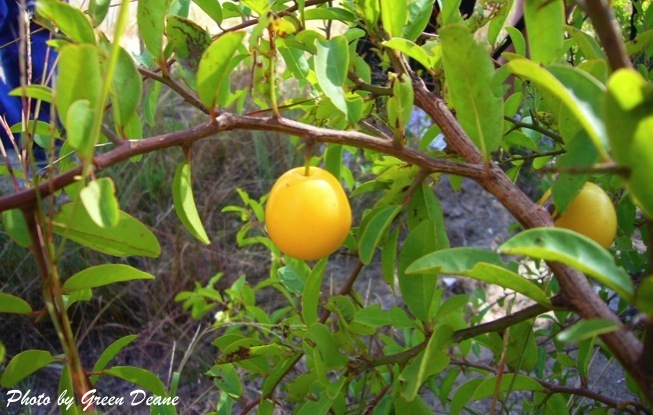
Tallow plums ripen to yellow, and sweeten. Photo by Green Deane
Though they have been mentioned several times they deserved to be repeated again. Now is the time to look for the yellow fruit of the tallow plum ximenia americana. At our last class in Melbourne we saw hundreds for ripe fruit on more than a dozen shrubs. Everyone had a good opportunity to study the species and taste the fruit.
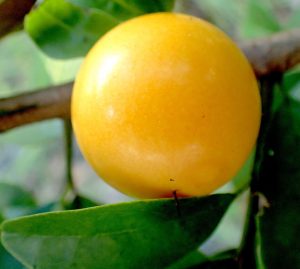
Ripe fruit is is golden yellow, some time redish yellow. Photo by Green Deane
In some part of the world Tallow Plum leaves are prime giraffe food (so I suspect our deer like them. I have found a fawn waiting for mom near tallow plums.) Eating the leaves is iffy for humans as they contain come cyanide though after long boiling are said to be edible. (I am not that hungry though I do eat the ripe fruit.) The ripe fruit are often used as a replacement for lemons in cooking. The seed oil (ximenyinc acid) has been used cosmetically. The oil when blended with kerosene can be used as a biofuel. The species has long been used in traditional medicine for treating measles, malaria, skin infections, veneral diseases, diarrhea, muscle cramps and lung abscesses. The fruit in excess is used to treat constipation. You can read more about it here.

Foraging classes are held rain, shine, hot or cold. Photo by Nermina Krenata
Storm dodging this week we start with a class Saturday in West Palm Beach where the Jambul tress should be fruiting. Sunday’s class will be a hybrid event. It will be held in Lake Mary at a favorite mushrooming site. Whether there will be mushroom is difficult to predict. It is also a location which has thousands of persimmon trees though persimmons are not ripe yet. This walk is exactly a mile long. We share the path with mountain bikes, deer, bear tracks, and an occasional rattle snake.
Sept 9th, Lake Mary, Fl, 8515 Markham Rd, Lake Mary, FL 32746. 9 a.m. to noon, meet at the bathrooms. Whether this is a plant class or a mushroom class (or more likely both) depends on whether the mushrooms are flushing. This location has produced chanterelles, puff balls, milk caps, boletes, russulas, ganodermas, and “white” chicken of the woods. Harvesting mushrooms in Florida is illegal so don’t be obvious such as carrying a mushroom basket. Paper bags in a backpack is less announcing.
This class is cancelled because my car died. Sept 10th, West Palm Beach, Dreher Park, 1200 Southern Blvd., West Palm Beach, 33405, 9 a.m. to noon, meet just north of the science center.
For more information, to pre-pay for a class, or to sign up go here.
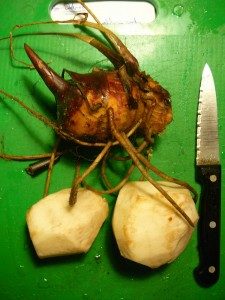
Canna roots
When it comes to plants you can see something for a long time but not see it. That was my experience with Canna. In the late 80’s a friend of mine had Canna planted along her house. As she was from Taiwan I presumed — like most of the plants around her home — they were native to Asia. As it turned out I was just one in a very long line of people thinking this native of the Americas was actually Asian. I didn’t make the connection to local Canna because the two species have different blossoms, one skinny and red, the other fat and yellow. But then one day while fishing along the St. Johns River east of Sanford I saw a large stand of “native” Canna and investigated. There are several edible parts to the Canna including the roots. The hard seeds, however, have been used as a substitute for buckshot… they are that hard. You can read more about this peripatetic beauty here.
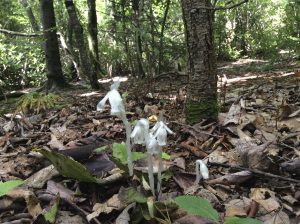
Ghost Pipes are a famine food. Photo by Green Deane
Several plants were called “Indian Pipes” where and when I was growing up. One of them is the Monotropa uniflora. Living more like a mushroom than a plant it sprouts up in various edibility conversations. It helps focus the issue on exactly what “edibility” means. Other than allergies, edibility does imply it will not kill you or harm you in any significant way. But “edibility” does not have to imply tasty. As forager Dick Deuerling used to say “there are a lot of edible plants. I only eat the good stuff.” There are also things that are just too woody or bitter to eat more than a sample of but are included in “edible.” And some plants have to be prepared correctly to be “edible.” Is the Monotropa uniflora edible? Yes. Does it taste good? Only if you’re really hungry. But that is understandable. The list of edible plants has to include everything from incredibly delicious food to only-if-I-were-starving food. Indian Pipes are closer to the famine food end of that list, the tops are more edible than the stems. You can read more about the Monotropa here.
In the olden BC days... before computers… Labor Day meant you went back to school the next day. School also let out sometime in June. Your release date was never exact because several “snow days” were built into the calendar every year. If they weren’t used up we got out in early June. If it was a bad winter then we got out mid-June. We also were not too far removed from harvest time on both ends of the school year.
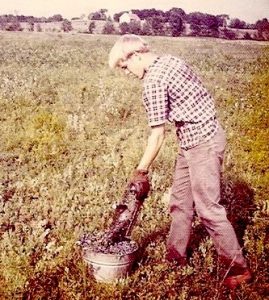
Harold Grandholm, a high school classmate, raking blueberries off the road I grew up on during “summer vacation.”
I walked to school daily, five miles round trip, and that was my preference. The wander took me past blueberry fields, Concord grape hedgerows, apple orchards and a great view of New Hampshire’s Mt. Washington some 60 miles away. I was scrumping every morning and afternoon for six weeks or so. This daily Too & Fro also included crossing the Royal River which was really more of a serf stream except during the spring floods. (Fished and fell into the Royal a lot. Found my first black pearl there and caught my first eel in the Royal.) All that wild fall fruit always ruined my supper but then again my mother was a horrible cook so it worked out well. Plants were also part of school letting out in spring. I noticed way back in sixth grade that when the (edible) Lilacs blossomed school was nearly out for the summer… and summer vacations were wrongly named: For most kids where I grew up it meant farm work until school started in September. For me it was three full months of working in the hay fields, a hot, dusty, hornet-punctuated job. My mother collected horses (and other farm animals) and they had to be fed so into the fields I went, indentured labor. There was also summer gardening, 70 days of it. I only escaped all that by volunteering for the Army in 1969 when Vietnam was hot… young men can make stupid decisions… but I never hayed again.
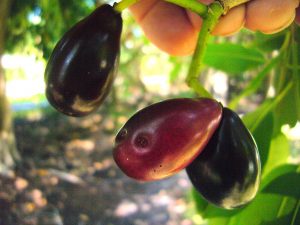
Even ripe Jambul fruit is slightly astringent. Photo by Green Deane
We mentioned above that the Syzygiums might be fruiting in West Palm Beach. That mostly included S. cumini also known as the Java Plum and Jambul. I’ve made wine out of that. There are a few Jambuls in Orlando and certainly dozens in West Palm Beach. I know they also grow well in Sarasota and Port Charlotte where I think they are naturalized. Both Syzygium jambos and Syzygium samaragense are called the Rose Apple and Java Apple (and many other names as well.) There also is a Syzygium in your kitchen is S. aromaticum. You know the dried flower buds as “cloves.” As the species have been in foraging news lately I decided to bite the proverbial bullet and write a second article on the genus, or at least the latest one. You can read that article here and you can read about the Jambul here.

You get the USB, not the key.
Changing foraging videos: My nine-DVD set of 135 videos has been selling for seven years and are still available. They are the same videos I have on You Tube. Some people like to have a separate copy. A second option is a16-gig USB that has those 135 videos plus 15 more. While the videos can be run from the DVDs the videos on the USB have to be copied to your computer to play. They are MP4 files. The150-video USB is $99 and the 135-video DVD set is now $99. The DVDs will be sold until they run out then will be exclusively replaced by the USB. This is a change I’ve been trying to make for several years. So if you have been wanting the 135-video DVD set order it now as the price is reduced and the supply limited. Or you can order the USB. My headache is getting my WordPress Order page changed to reflect these changes. We’ve been working on it for several weeks. However, if you want to order now either the USB or the DVD set make a $99 “donation” using the link at the bottom of this page or here. That order form provides me with your address, the amount — $99 — tells me it is not a donation and in the note say if you want the DVD set or the USB.

Green Deane Forum
Want to identify a plant? Perhaps you’re looking for a foraging reference? You might have a UFO, an Unidentified Flowering Object, you want identified. On the Green Deane Forum we — including Green Deane and others from around the world — chat about foraging all year. And it’s not just about warm-weather plants or just North American flora. Many nations share common weeds so there’s a lot to talk. There’s also more than weeds. The reference section has information for foraging around the world. There are also articles on food preservation, and forgotten skills from making bows to fermenting food.
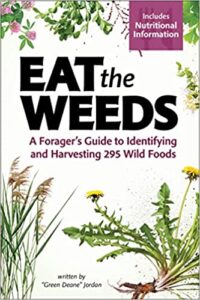 Now being printed is EatTheWeeds, the book. It should have 275 plants, 350-plus pages, index and color photos. Several hundred have been preordered on Amazon. Most of the entries include a nutritional profile. Officially it will be published Dec. 5th (to suit the publisher demands) apparently to appeal to the winter market but can be delivered by mid-October
Now being printed is EatTheWeeds, the book. It should have 275 plants, 350-plus pages, index and color photos. Several hundred have been preordered on Amazon. Most of the entries include a nutritional profile. Officially it will be published Dec. 5th (to suit the publisher demands) apparently to appeal to the winter market but can be delivered by mid-October
This is weekly newsletter #572, If you want to subscribe to this free newsletter you can find the sign-up form in the menu at the top of the page.
To donate to the Green Deane Newsletter click here.

